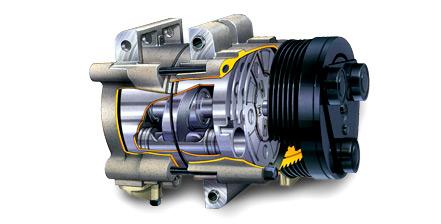
The US Energy Department has issued very stringent requirements for air conditioning manufacturers out of concern for the environment and the effects of greenhouse gases. The effort to reduce energy consumption started in the 1970s and by 1992 conservation standards were in place. Since the 1990s until today, these standards have resulted in new air conditioners using fifty percent less energy.
Did you know ice cubes do not cool the liquid down around it? Gradually moving molecules in the ice move slowly and when added to the fast-moving particles in the liquid, it causes a transfer of energy. Ice cubes transfer the heat from the fluid into the cube. In this same way, a home air conditioner also works by taking heat away.
A home air conditioner is made up of five mechanical components:
The “hot” side of a home air conditioner usually consists of a condensing coil, compressor, and a fan. The “cool” side of a home air conditioner is located inside your furnace in a closet or hidden area of the home.
Your compressor is the heart of the air conditioner. It keeps the flow of refrigerant flowing through the system at specified pressures and flow rate. The compressor uses refrigerant vapor and converts it from the low-pressure side to the high-pressure side as it moves through the system. Rate of flow through the system, operating pressures, and evaporator temperatures will all depend on the size of the unit.
The Condenser Coil is located on the exterior of your home. When the condenser fan turns on, it is removing the warmth from the inside your home. This warmth consists of the vapors that are inside the coil. The condenser also is an intake of hot outside air to enter back into the system.
As a homeowner, it is imperative that you keep this outdoor unit clean of debris and routinely checked by a licensed professional to make sure all internal components are operating correctly. A dirty coil can be very costly to a homeowner.
Remember the ice analogy? The condenser is where the hot refrigerant vapor from the compressor enters into the condenser, and the cold condenser coils absorb the heat from the gas. The exchange is what causes the air to condense, the same as the ice taking heat in from the liquid.
Air-cooled refrigeration systems and home air conditioners are intended only to condense the refrigerant to a temperature around 25 to 30 degrees above the outside ambient air temperature. For example, in Texas, if the outdoor thermometer reads 80 degrees, the refrigerant temperature will be about 105 to 115 degrees when it first condenses.
You want the refrigerant to condense at this relatively high temperature, so the air will be extremely cold comparative to the temperature of the discharge vapor. When this occurs, the latent heat energy in the gas transfers to the relatively cold air and causes the refrigerant to condense. This condensing action causes all of that hot air that blows out of your outside unit originates.
After the high-pressure refrigerant is heated back up from moving through the condenser, it runs through a filter drier that helps to prevent debris from flowing into the system and then to a metering device. This device is critical because it is the dividing point between the high-pressure side of the system and the low-pressure side of the system. This meter is designed to maintain a specific rate of flow of refrigerant into the low side of the system.
When the refrigerant passes through the metering device, the drop in psi goes from a psi of 225 to 70. It also drops the temperature of the coolant from around 110 degrees to approximately 40 degrees, and it starts to evaporate immediately. If a wrong metering device is installed on a unit, an incorrect quantity of refrigerant will enter into the evaporator causing it to explode and spew like a shook up warm soda.
Provided your metering device is fully functional, reasonably warm air will be flowing over the evaporator coils. The refrigerant will evaporate in the evaporator at a temperature of approximately 40 degrees, and that would be considered cold in comparison to the warm air flowing over it. Heat in the warm air streaming over the evaporator will be absorbed by the cold evaporative refrigerant.
When the air cools due to the heat being absorbed, again like the ice cube, it causes cold air that is pushed into your home by way of air ducts. The blower or fan of your home air conditioning unit is in an area that is not seen, like a closet or pantry. A lot of times, this unit is located will be in a home attic.
There are many places along the route of air flow that dust and debris can enter the system. The number one thing you can do as the homeowner to keep your system as efficient as possible is to keep your filter clean. Most systems have disposable filters and although these can seem expensive when you are in the store shopping, the cost saving they are responsible for will pay you back tenfold. Clogged filters restrict air flow and cause the system to operate inefficiently.
Keeping up with the yearly maintenance of your unit is also very important. It has already been mentioned to keep debris away from your outside unit. It is also a good idea to have a licensed HVAC technician come by and do routine maintenance and make sure everything is operational at least once a year. Most homeowners do this in the spring.

Licensed and Insured
H.S. Hill MPL 37466 & Kirk Brandli TACLB53102E
All prices are subject to change.